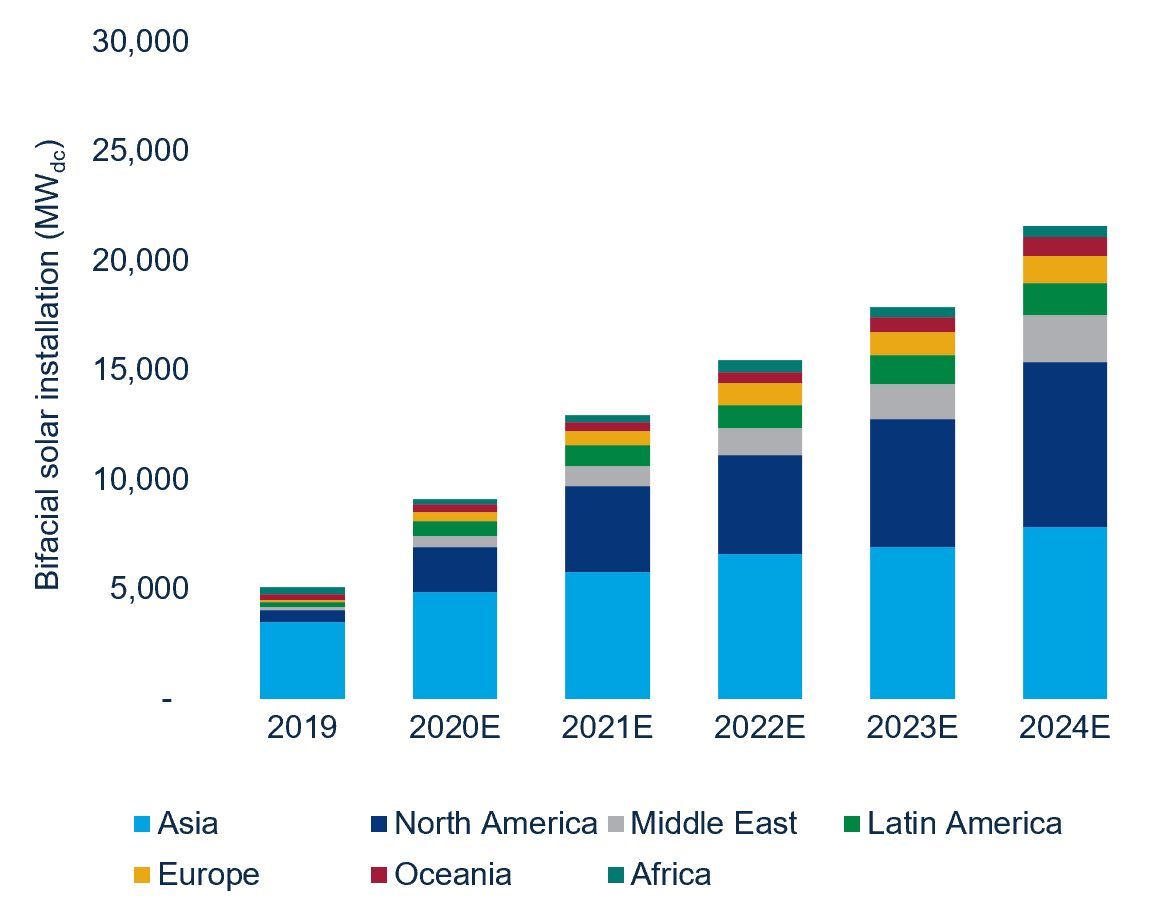Bifacial solar modules are the new normal for developer Lightsource BP, the company tells GTM.
Lightsource BP, among Europe's largest solar developers, installed a bifacial test system in Northern Ireland in 2018. Real-world data from that has made the company comfortable using the technology for its latest projects. Now other big European developers are gearing up to do the same in 2020.
“From the latter part of 2019 going forward, every single one of our sites, including the U.S., Australia and the most recent 250 megawatts [we installed] in Spain, are using bifacial technologies,” Chris Buckland, technical director at Lightsource BP, said in an interview.
"Now there is no debate"
2019 was a breakout year for bifacial solar technology, with global installations doubling compared to 2018, according to data from Wood Mackenzie.
One of the challenges for bifacial solar has been quantifying how much extra power the rear side of the panel can generate. In order to finance projects against that extra power, it needs to be quantified in a way that investors are comfortable with.
Early projects have been exceedingly conservative on this crucial figure, as have manufacturers, opting for low-single-digit percentages. But if a project can operate for a few years and generate that site-specific, real-world data, it can then be refinanced with higher generation figures, which means lower interest rates.
Buckland said the increase in generation from the test site in Northern Ireland shows that the generation boost comfortably offsets the price premium on the modules.
“Within the U.K., we will be very disappointed if we see less than 8 percent of uplift, provided that the rest of the system has been engineered appropriately. We are seeing up to 12 percent additional yield coming out, particularly in less sunny regions such as Northern Ireland,” he said.
“In Europe, 8 to 12 percent, depending on where you are, is certainly something that we feel very confident in, and our investors are on board with that today,” added Buckland.
“We’ve had to show this [extra] reach to our investors and selected technology advisers to get buy-in for the technology, but now there is no debate,” he said.
Lightsource BP, which is 50 percent owned by oil giant BP, is targeting 10 gigawatts of solar projects globally by 2023.

Asia has dominated the bifacial market so far, in large part due to Chinese subsidies for advanced technologies. (Credit: WoodMac)
Although not a new concept, bifacial modules have only recently been manufactured in significantly large volumes. Manufacturers are still enhancing the technology. Trina Solar just launched a 500-watt module, while others are offering transparent backsheets instead of a glass backing to cut weight.
There will be further room for improvement as the technology travels along its very own development path. With that in mind, some cutting-edge bifacial panels have been included as part of the Lightsource BP's 4.9-megawatt system built for brick manufacturer IBStock, to serve a similar role as the Northern Ireland site has done for previous versions of the technology.
Jan Muller, technical and asset management director at the developer Solarcentury, expects to see his own company develop its first full-scale project this year. They are also embedding some small sections of bifacial modules into larger projects to build up their own bank of data. That’s crucial given how much of the data available to developers at the moment is coming directly from the manufacturers.
Muller expects module availability to be another driving factor as more and more of the company's output switches to bifacial.
At the moment both Solarcentury and Lightsource BP are using or intend to use double glass modules. They have lower degradation rates, which Muller said can also take some risk out of the investment.
To track or not to track
All in all, bifacial offers more power, less degradation, and, if combined with trackers, a less peaky production curve.
“We’re now pushing at an open door. They really go hand in hand with trackers,” Muller said, which means a lower proportion of ground coverage at each site, less visual impact and better biodiversity.
Lightsource BP expects to stick with fixed bifacial systems in the U.K and other parts of northern Europe for now. This month it confirmed a bifacial plant in Spain would indeed also be making use of trackers. Buckland said there could be an opportunity for merchant power to stimulate tracker use as power prices are better toward the ends of those early-morning and late-afternoon production tails.
Gridserve completed the first bifacial-plus-tracker system in the U.K. last year. That 34.7-megawatt site also benefits from a 30-megawatt-hour battery.
“The additional synergy that you get from adding different technologies together is what gives you the extra value that you don't have for each individual technology by itself," Gridserve CEO Toddington Harper told GTM when the project became grid-connected in December 2019.
“I would say it is entirely replicable. That’s probably the most exciting thing about this project for us,” he added.




